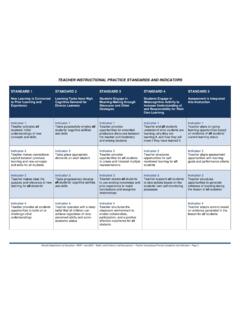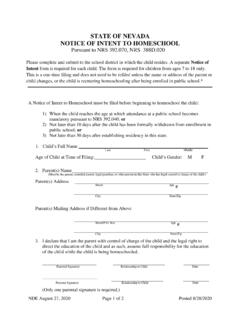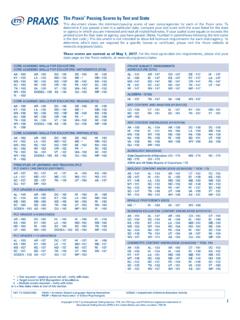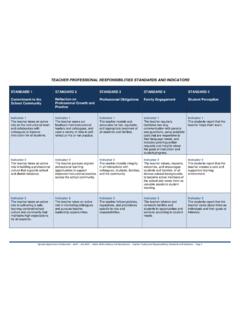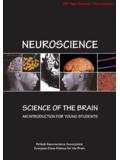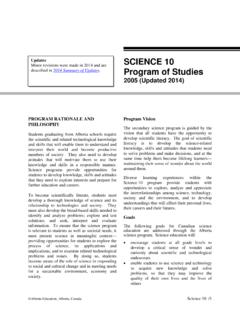Transcription of Nevada State Academic Content Standards for Science …
1 Nevada Academic Content Standards for Science (Topics) February 2014 2013 Lead States All Rights Reserved 1 | Page Nevada Academic Content Standards for Science (Topics) February 2014 2013 Lead States All Rights Reserved 2 | Page Table of Contents Elementary introduction .. 5 Kindergarten Storyline .. 6 K. Interdependent Relationships in Ecosystems: Animals, Plants, and Their Environment .. 8 K. Weather and Climate .. 10 K. Interdependent Relationships in Ecosystems: Animals, Plants, and Their Environment .. 11 K. Weather and Climate .. 13 First Grade Storyline .. 15 1. Waves: Light and Sound .. 16 1. Structure, Function, and Information Processing.
2 17 1. Space Systems: Patterns and Cycles .. 19 Second Grade Storyline .. 20 2. Structure and Properties of Matter .. 21 2. Interdependent Relationships in Ecosystems .. 23 2. earth s Systems: Processes that Shape the earth .. 24 K-2. Engineering Design .. 25 Third Grade Storyline .. 26 3. Forces and Interactions .. 27 3. Interdependent Relationships in Ecosystems .. 29 3. Inheritance and Variation of Traits: Life Cycles and Traits .. 31 3. Weather and Climate .. 33 Fourth Grade Storyline .. 34 4. 35 4. 37 4. Structure, Function, and Information Processing .. 38 4. earth s Systems: Processes that Shape the earth .. 39 Fifth Grade Storyline.
3 41 5. Structure and Properties of 42 5. Matter and Energy in Organisms and Ecosystems .. 44 5. earth s Systems .. 46 5. Space Systems: Stars and the Solar System .. 47 3-5. Engineering Design .. 48 Middle School Physical Science .. 49 Middle School Physical Science Storyline .. 49 Middle School Physical Science Storyline (continued) .. 50 Middle School Life sciences Storyline .. 51 Middle School Life sciences Storyline (continue) .. 52 Nevada Academic Content Standards for Science (Topics) February 2014 2013 Lead States All Rights Reserved 3 | Page Middle School earth and Space sciences .. 53 Middle School earth and Space sciences .
4 53 Middle School earth and Space sciences (continued) .. 55 Middle School Engineering Design .. 56 MS Physical Science Standards .. 57 MS. Structure and Properties of Matter .. 57 MS. Chemical Reactions .. 59 MS. Forces and Interactions .. 61 MS. Energy .. 63 MS. Waves and Electromagnetic Radiation .. 65 MS. Structure, Function, and Information Processing .. 67 MS Life Science Standards .. 69 MS. Interdependent Relationships in Ecosystems .. 69 MS. Growth, Development, and Reproduction of Organisms .. 70 MS. Natural Selection and Adaptations .. 72 MS earth and Space Science Standards .. 74 MS. Space Systems .. 74 MS. History of earth .
5 76 MS. earth s Systems .. 78 MS. Weather and Climate .. 80 MS. Human Impacts .. 82 MS. Engineering Design .. 84 High School Physical sciences Storyline .. 86 High School Physical sciences Storyline (continued) .. 87 High School Physical sciences Storyline (continued) .. 88 High School Life sciences Storyline .. 88 High School Life sciences Storyline (continued) .. 89 High School earth and Space sciences Storyline .. 90 High School earth and Space sciences Storyline (continued) .. 91 High School Engineering Design .. 92 HS. Physical sciences .. 93 HS. Structure and Properties of Matter .. 93 HS. Chemical Reactions .. 95 Forces and Interactions.
6 97 HS. 99 HS. Waves and Electromagnetic Radiation .. 101 Nevada Academic Content Standards for Science (Topics) February 2014 2013 Lead States All Rights Reserved 4 | Page HS. Life sciences .. 103 HS. Structure and Function .. 103 HS. Matter and Energy in Organisms and Ecosystems .. 105 HS. Interdependent Relationships in Ecosystems .. 107 HS. Inheritance and Variation of Traits .. 110 HS. Natural Selection and Evolution .. 112 HS. Space Systems .. 114 HS. History of earth .. 116 HS. earth s 118 HS. Weather and Climate .. 120 HS. Human Sustainability .. 122 HS. Engineering Design .. 124 Nevada Academic Content Standards for Science (Topics) February 2014 2013 Lead States All Rights Reserved 5 | Page Elementary introduction Students in kindergarten through fifth grade begin to develop an understanding of the four disciplinary core ideas: physical sciences ; life sciences ; earth and space sciences ; and engineering, technology, and applications of Science .
7 In the earlier grades, students begin by recognizing patterns and formulating answers to questions about the world around them. By the end of fifth grade, students are able to demonstrate grade-appropriate proficiency in gathering, describing, and using information about the natural and designed world(s). The performance expectations in elementary school grade bands develop ideas and skills that will allow students to explain more complex phenomena in the four disciplines as they progress to middle school and high school. While the performance expectations shown in kindergarten through fifth grade couple particular practices with specific disciplinary core ideas, instructional decisions should include use of many practices that lead to the performance expectations.
8 Nevada Academic Content Standards for Science (Topics) February 2014 2013 Lead States All Rights Reserved 6 | Page Kindergarten Storyline The performance expectations in kindergarten help students formulate answers to questions such as: What happens if you push or pull an object harder? Where do animals live and why do they live there? What is the weather like today and how is it different from yesterday? Kindergarten performance expectations include PS2, PS3, LS1, ESS2, ESS3, and ETS1 Disciplinary Core Ideas from the NRC Framework. Students are expected to develop understanding of patterns and variations in local weather and the purpose of weather forecasting to prepare for, and respond to, severe weather.
9 Students are able to apply an understanding of the effects of different strengths or different directions of pushes and pulls on the motion of an object to analyze a design solution. Students are also expected to develop understanding of what plants and animals (including humans) need to survive and the relationship between their needs and where they live. The crosscutting concepts of patterns; cause and effect; systems and system models; interdependence of Science , engineering, and technology; and influence of engineering, technology, and Science on society and the natural world are called out as organizing concepts for these disciplinary core ideas.
10 In the kindergarten performance expectations, students are expected to demonstrate grade-appropriate proficiency in asking questions, developing and using models, planning and carrying out investigations, analyzing and interpreting data, designing solutions, engaging in argument from evidence, and obtaining, evaluating, and communicating information. Students are expected to use these practices to demonstrate understanding of the core ideas. Nevada Academic Content Standards for Science (Topics) February 2014 2013 Lead States All Rights Reserved 7 | Page K. Forces and Interactions: Pushes and Pulls Students who demonstrate understanding can: K- PS2-1.

